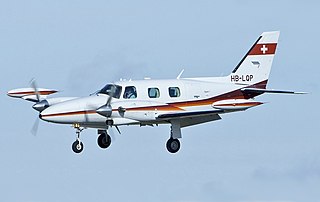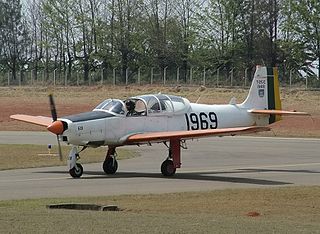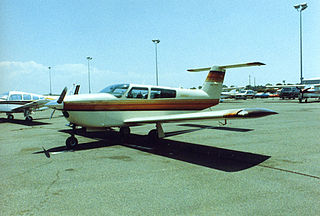
The Antonov An-14 Pchelka or Pchyolka, Bdzhilka is a Soviet utility aircraft which was first flown on 15 March 1958. It was a twin-engined light STOL utility transport, with two 300 hp Ivchenko AI-14RF radial piston engines. Serial production started in 1966, and about 300 examples were built by the time production ended in 1972. The An-14 failed to replace the more successful An-2 biplane, which was manufactured until 1990; the An-2 is still manufactured on special order. The An-14's successor, the An-28 with turboprop engines, is still manufactured at PZL Mielec factories in Poland, under the names PZL M28 Skytruck and PZL M28B Bryza.

The Cessna 425, known as the Corsair and later as the Conquest I, is an eight-seat American pressurized turboprop twin-engined light aircraft. Now out of production, it was built by Cessna Aircraft of Wichita, Kansas, between 1980 and 1986.

The Piper PA-31T Cheyenne is a twin-engine turboprop development of the earlier PA-31P Pressurized Navajo.

The Harbin Y-11 is a high wing twin-engine piston utility and geological survey aircraft built by Harbin Aircraft Manufacturing Corporation (HAMC).

The Saunders ST-27 was a regional aircraft built in the 1970s by the Canadian Saunders Aircraft Company based at Gimli, Manitoba. The aircraft was designed as a conversion of the earlier de Havilland Heron. The conversion program was extensive and featured two Pratt & Whitney Canada PT6 turboprops and a stretched fuselage. Despite its promise as a regional airliner, the project collapsed when Manitoba government funding was withdrawn in 1976.

The AIDC T-CH-1 Chung Hsing was a turboprop-powered military trainer aircraft produced in Taiwan.
The Anahuac Tauro is a Mexican agricultural aircraft built in small numbers in the late 1960s and 1970s. The first prototype flew on 3 December 1968, with Mexican Type certification following on 8 August 1969. It was a low-wing braced monoplane of conventional configuration with fixed tailwheel undercarriage. The wing was of constant chord and had spray bars installed along its trailing edge.

The Piaggio P.166 is an Italian twin-engine pusher-type utility aircraft developed by Piaggio Aero. The aircraft model name was Portofino, and is also known as Albatross in South African military service.

The Neiva N621 Universal is a Brazilian propeller-driven basic trainer and ground attack aircraft manufactured by Indústria Aeronáutica Neiva. It is a cantilever, low-wing monoplane of all-metal construction, with retractable undercarriage and side-by-side seating.

The Bellanca T-250 Aries was a light airplane built in the United States in the early 1970s, which achieved only limited production. Designed by Marvin Greenwood in Texas while his company, Anderson-Greenwood, owned the Bellanca name, it was offered as a Bellanca product. It was a conventional low-wing monoplane with retractable tricycle undercarriage and a high T-tail. Federal Aviation Administration type certification was obtained on 28 July 1976.

The Found Centennial 100 is a Canadian six-seat cabin monoplane produced by Found Brothers Aviation.

The Gulfstream American Hustler was a 1970s American mixed-power executive/utility aircraft designed by American Jet Industries, which later changed to Gulfstream American Corporation. The aircraft had a nose-mounted turboprop and a tail-mounted turbofan.
The DSK Airmotive DSK-1 Hawk was an unusual homebuilt aircraft designed in the United States in the early 1970s. While the design itself was utterly conventional - a single-seat low-wing cantilever monoplane with fixed tricycle undercarriage - its method of construction was not, since the DSK-1 Hawk used a surplus 200 US Gal military drop tank as its fuselage. Designer Richard Killingsworth sold over 250 sets of plans.

The SIAI-Marchetti SM.1019 is an Italian STOL liaison monoplane built by SIAI-Marchetti for the Italian Army. It is a turboprop-powered derivative of the Cessna O-1 Bird Dog.

The Wing D-1 Derringer is an American light twin-engined two-seat monoplane tourer designed by John Thorp and developed by the Hi-Shear Corporation and built by the Wing Aircraft Company.

The Vulcanair SF.600 Canguro was a feederliner developed in Italy in the late 1970s. Despite a number of attempts to put the aircraft into series production, only a small number were ever built.

The Italair F.20 Pegaso was a twin-engine utility aircraft designed by Stelio Frati and built in Italy in 1971.

The IAR-827 was an agricultural aircraft built in Romania in the 1970s and 1980s. The penultimate member of the family of designs that began with the IAR-821, it was, like the others, a conventional low-wing monoplane with fixed, tailwheel undercarriage, and shared the all-metal construction of the IAR-826. The prototype flew in 1976, powered by a Lycoming IO-720 engine, but the production examples that followed all had the PZL-3S.

The NAC Fieldmaster was a British agricultural aircraft of the 1980s. A turboprop powered single-engined monoplane, it was built in small numbers and used both as a cropsprayer and a firefighting aircraft.
The O'Neill Model J Magnum, also called the Magnum Jake and the Magnum Pickup, is a homebuilt aircraft design for bush flying operations similar to the de Havilland Beaver.

















